- Home
- Edward Cline
Sparrowhawk III
Sparrowhawk III Read online
Sparrowhawk III - Caxton
Edward Cline
ebook ISBN: 978-1-59692-945-6
for more great titles visit:
www.skoobestore.com
M P Publishing Limited
12 Strathallan Crescent
Douglas
Isle of Man
IM2 4NR
via United Kingdom
Telephone: +44 (0)1624 618672
email: [email protected]
Originally published by:
MacAdam/Cage
155 Sansome Street, Suite 550
San Francisco, CA 94104
www.macadamcage.com
Copyright © 2003 by Edward Cline
ALL RIGHTS RESERVED.
Library of Congress Cataloging-in-Publication Data
Cline, Edward
Sparrowhawk book three : Caxton / by Edward Cline.
p. cm. -- (Sparrowhawk series ; bk. 3)
ISBN: 1-931561-53-2 (Hardcover : alk. paper)
1. Virginia—History—Colonial period, ca. 1600-1775—Fiction.
I. Title: Caxton. II. Title.
PS3553.L544S626 2003
813’.54—dc22
Paperback Edition: December 7, 2004
ISBN: 1-931561-88-5
Jacket painting “Sketch of Yorktown” by Benjamin Henry Latrobe 1764–1820
Book and jacket design by Dorothy Carico Smith
Publisher’s Note: This is a work of fiction. Names, characters, places, and incidents either are the product of the author’s imagination or are used fictitiously. Any resemblance to actual events, locales, or persons, living or dead, is entirely coincidental.
MACADAM CAGE
The special province of drama
“is to create…action…which springs from the past but is directed toward the future and is always great with things to come.”
— Aristotle, On Drama
Caxton (Sparrowhawk III)
A novel by Edward Cline
Contents
Foreword
Chapter 1 - The Visitors
Chapter 2 - The Town
Chapter 3 - The Plantation
Chapter 4 - The Ball
Chapter 5 - The Encounter
Chapter 6 - The Empty Houses (i)
Chapter 7 - The Empty Houses (ii)
Chapter 8 - The Newcomer
Chapter 9 - The Master
Chapter 10 - The Host
Chapter 11 - The Olympians
Chapter 12 - The Governor
Chapter 13 - The Freeman
Chapter 14 - The Rivals
Chapter 15 - The Conduit
Chapter 16 - The Riddle
Chapter 17 - The Hiatus
Chapter 18 - The Journey Home
Chapter 19 - The Homecoming
Chapter 20 - The Member for Swansditch
Chapter 21 - The Voyage Home
Chapter 22 - The Bellwether
Chapter 23 - The Autumn
Chapter 24 - The News
Chapter 25 - The Words
Edward Cline: Sparrowhawk
Foreword
The complaint most often lodged against a certain genre of fiction is that, “Things like that don’t happen in real life!” or, “Life isn’t like that!”
But, they do. And, it can be like that.
Case in point: The American Revolution — a heroic and successful revolt against tyranny, resulting in the establishment of a republic (if we can keep it, to paraphrase Benjamin Franklin) whose government was charged with protecting and upholding life, liberty, and the pursuit of happiness — and property, which facilitates and is integrally linked to the first three political ends. If judged by the criteria of Romantic literature — it being, in novelist/philosopher Ayn Rand’s words, a “category of art based on the recognition of the principle that man possesses the faculty of volition” — then the founding of the United States was the most glorious and dramatic political event in human history, unimaginable in fiction before then, and virtually unprecedented since, whether in “real life” or in fiction.
Most nations can claim a literature, in the form of novels, plays, or epic sagas or poetry, that dramatizes the early histories of those countries. Britain, France, and Spain come to mind. But, except for a handful of novels that dramatize, usually in superficial costume dramas or in sheer action at various levels of literary worth, specific periods or events in American colonial history, America has no such literature. A large body of novels exists for the Civil War, the Indian Wars, even World War II. The colonial period’s list is pitifully, almost scandalously short. Representative of this specific subgenre is James Fenimore Cooper’s The Last of the Mohicans. The Sparrowhawk series of novels represents, in part, an ambitious attempt to help correct that deficiency.
I say “in part,” because my overall end is to write a story that interests me as a writer, and not specifically to contribute to this country’s literature. That could well be a consequence, but it is not my motive. However, I am not unmindful of that consequence, and so this series will also attempt to do justice to the founding of the United States. And doing justice to it has meant understanding, in fundamentals, what moved the Founders to speak, write, and act as they did. Those fundamentals were ideas.
Except for some “cameos” by the Founders, such as Patrick Henry and Thomas Jefferson, this series does not dramatize the characters and actions of real historical persons. Instead, it focuses on the intellectual and moral development of two men, Jack Frake and Hugh Kenrick, Englishmen who come to the colonies and who reflect the moral and intellectual stature of the men who made this country possible.
Jack Frake, a boy who was brought here as an indentured felon, and Hugh Kenrick, an aristocrat who was sent here to complete his education, are two variations on the same theme: the inviolate, rational, self-made individual. As a former smuggler, Jack is a veteran of harsh conflict, social ostracism, and criminal defiance. As a critic of the customs and conventions of his time, Hugh is a literate rebel against hypocrisy and venality. Jack receives his education in a Cornwall cave, tutored by a colorful outlaw; Hugh, his in the safety of his Dorset home and in the best schools in London. Yet, although a social chasm separates their origins, both men meet at the same point of independence and self-reliance, and make decisions that affect the course of their lives.
This third volume opens in colonial Virginia. Jack and Hugh, however, are introduced in the first two titles of the Sparrowhawk series, which are set entirely in the England of the 18th century, in the decades immediately preceding the beginning of serious conflict between the mother country and her colonies. England was the proper setting for the outset of this series, for it was chiefly British political ideas and philosophy, espoused by 17th century thinker John Locke and his contemporaries and predecessors, that animated the colonials throughout the 18th. Book Three: Caxton moves from the stark cliffs of Cornwall and the roiling streets of midcentury London to the deceptively placid rivers, hills and towns of colonial Virginia.
Alarmed by a stealthy, and later blatantly aggressive encroachment on their constitutionally guaranteed rights by Parliament and King George the Third, American political intellectuals advocated and applied these ideas to their own lives to a degree unimaginable to the British political establishment. Unimaginable, and inimical to it, for while that establishment paid lip service to life, liberty, and property, in fact it largely rested on a corrupt and corrupting system of unquestioning servitude, arbitrary expropriation, and a resigned tolerance of that servitude, expropriation, and corruption.
The taking of such ideas so seriously by men that they would pledge their lives, fortunes, and sacred honor to fight for them was both inimical to that establishment, and nearly a p
ersonal affront to 18th-century Britain, which prided itself for being the freest country on earth, which many patriots and persecuted individuals from other countries looked to as a beacon of hope or chose as a place of resident exile.
However, American political intellectuals were steeped in Roman and Greek history, as well as British and Continental political philosophy, and learned from it, drawing from it important lessons of cause and effect, of means and ends. As British legislators grew more arrogant and implacable in their demands on the colonies, the well-read American “activist” would have been knowledgeable enough to remark: “When Tiberius asked Cato why the Dalmatians revolted from Rome, he replied that it was ‘because the Romans sent not dogs or shepherds, but wolves to guard their flocks.’” And, he would have subsequently concluded that he was not a member of anyone’s flock, needing neither trained dog, nor gentle shepherd, nor predatory wolf to live his own life for his own reasons.
If conflict is the driving force of plot, then Sparrowhawk is a plotted saga. Jack and Hugh may meet at the same point of independence, and even become friends, but is their relationship smooth and frictionless? If it isn’t, why isn’t it? As one character in this present volume remarks: “One of you is the needle, and one of you the north.” Who is the ideal, and who is the aspirant to that ideal? That is for readers to find out. And, having found out, to read on to learn why.
Historical fiction differs from “contemporary” fiction only in the amount of research required to re-create a period’s culture and society. Other than that, plot, characterization and action should be its chief attributes. Difficulties may be imagined in that one’s characters are moving and thinking in a period defined by its recorded events, and so the element of volition surely must be compromised. Not necessarily. In the Sparrowhawk series, history is always in the background, and its characters are the story’s movers.
Also, accuracy in re-creating a period is of paramount importance, but should not govern the course or content of a story. License may be taken and accepted, so long as it captures the essentials of a period’s customs, practices, and institutions. If this were not true, historical fiction would be impossible to write. Victor Hugo could not have had Quasimodo pour molten lead onto a 15th-century mob from the gallery of a cathedral in Notre Dame de Paris, and Hemingway could not have had Robert Jordan blow up bridges in For Whom the Bell Tolls in 1930s Spain. Edmond Rostand’s Cyrano de Bergerac could never have flashed his sword in 17th-century France, and Robert Bolt’s (or Terence Rattigan’s) T. E. Lawrence could never have taken Aquaba in Lawrence of Arabia (or in Ross) during World War I. The events depicted in these and other works of historical fiction didn’t happen in “real life,” and often their authors “fudged” on insignificant historical details to make a point. In fiction, and especially in historical fiction, what might or ought to have been is more important than what actually happened.
This is the crucial difference between historical fact and historical fiction. Aristotle emphasized the distinction over 2,000 years ago in his Poetics. He and John Locke, though they never set foot in America, were this country’s chief philosophical founders. And Sparrowhawk will be judged, I hope, a worthy testament to their continued role in men’s lives and minds.
Long live Lady Liberty!
Edward Cline
Yorktown, Virginia. January 2004
Chapter 1: The Visitors
In early October, 1759, the sloop Amelia dropped anchor at Caxton on the York River. From Philadelphia she carried cargo, visitors, and news. The cargo was expected, as were some of the visitors. The news was not. It was good news, and important news, and it brought elation to the
Virginia town, prompting some men to propose endless rounds of toasts in the taverns, and some women to kneel in prayer in thanks and gratitude. Others thought that the news deserved a regular celebration by firing the old cannon that stood on the sheriff’s property and holding a dance. One small planter was so excited that he put his twelve-year-old son on a horse and sent him off to Williamsburg with the news. Reverend Albert Acland, pastor of Stepney Parish Church, was pressed by a number of citizens to ring the church bell, but he advised waiting until the news was confirmed.
The news curtailed curiosity and speculation about two of the visitors who stepped off the sloop. They were strangers. One was a man of about forty, the other a young gentleman of nineteen or twenty. Both were finely dressed in clothes of the very best quality. They were the last passengers to step off the Amelia, once it was secured to the finger pier and the gangway lowered. The older man was courtly but amiable, the younger grave in the set of his face, almost forbidding. In the older man, there was a slight hint of deference to the younger. Once ashore, he made enquiries at the customs house, and paid a pair of idle boys to carry his and his companion’s traveling bags and follow him and his companion up the dirt road to the town above the bluff.
Three men were expecting the strangers, who had come on business, but did not meet them, for the sailing time from Philadelphia to the York River could have lasted between two and four days, depending on the winds and the water. These three men were Arthur Stannard, Ian McRae, and Amos Swart. Stannard was the consignment agent for the London tobacco merchants Weddle, Umphlett and Company. McRae was the York River’s sole Scottish factor, representing the Glasgow tobacco merchants Sutherland and Bain. Together, they were the principal creditors of Amos Swart, whose plantation was ordered into receivership by a county court in lieu of large and long-standing debts. Swart was persuaded to liquidate his debts in a single stroke by selling his property, which consisted of nearly one thousand acres of arable land, a great brick house and its outbuildings, livestock, wagons, tools and other implements, the indentures of five servants, and thirty slaves. He agreed to accept whatever price and terms a buyer might reach with Stannard and McRae, and to vacate the property once the sale was registered with the Queen Anne County court.
Swart had tried, in the summer, to placate his creditors by holding a lottery, offering as a prize the unconditional, ten-year lease of three hundred acres of his best land for a penny a year, and the free use of some of his slaves to clear and cultivate it. The proceeds from the ticket sales would have erased some of his debt. But few men purchased the tickets. Swart was not liked. He had married into his property — Brougham Hall — and out of his class. To the gentry, he was crude, obnoxious, unread; little better than a fur trapper from the mountains. To other, smaller planters, he was a cheat, a liar, and a thief. To all he was a rogue who had come from nowhere and ingratiated himself with the late, respected Covington Brougham, and had married his daughter, Feli´se. The daughter died mysteriously one night four months after their marriage. Title to Brougham Hall reverted automatically to Swart.
That had been six years ago. The townsmen, planters, and sheriff all suspected murder. The charge could not be proved. Brougham Hall went into decline. Swart owned smaller properties to the west, in other counties, and it was said that these were as badly managed by him as was now Brougham Hall. Residents of Caxton regarded Swart as a blot on their town’s reputation as a loyal and prosperous community; he was as repellent as a pirate; he was a seducer of virtuous women and wives; a corrupter of youth; and certainly not a crop master.
When the lottery failed, Stannard and McRae formed an alliance and sued Swart. The nine-man bench of the county court, composed mostly of planter gentry, examined the case and with ill-concealed alacrity ordered Brougham Hall into receivership. Advertisements were placed by the creditors in the Virginia Gazette and the Caxton Courier, which appeared twice a month. A stray copy of the Courier found its way to Tun Tavern in Philadelphia. The older stranger and his companion patronized that establishment, had seen the advertisement, and an exchange of letters between them and the creditors had led to the visit today.
The older gentleman’s name was Otis Talbot, of Talbot and Spicer, Philadelphia merchants. He was acting by proxy for Baron Garnet Kenrick of Dorset, England, having
been granted the power and means to purchase any property that the baron’s son expressed an interest in. By written agreement, once the son reached his majority at the age of twenty-one, title to such property would automatically revert to him.
Talbot’s companion was Hugh Kenrick, recently graduated from the Philadelphia Academy. He was nearly twenty.
They made their way to the house of Arthur Stannard on Queen Anne Street, the town’s only thoroughfare. The news spreading through Caxton was old news to them. They understood its significance as well as any Virginian.
France had lost Canada — and, as a consequence, North America.
* * *
Quebec had fallen, and the French had lost their ablest general there, Louis Joseph de Montcalm de Saint-Veran. His error — and it was not so much an error as an only choice — was to fight the British on their terms, in the first Continental style battle in North America. He and his army of regulars and Canadians awoke on the morning of September 13th to find 4,500 British regulars arrayed against them, ready for battle or siege, on a plateau called the Plains of Abraham. In an unusual and daring maneuver — unusual and daring at least for a British general — Brigadier General James Wolfe had overnight slipped his army up the cliffs from the river so quietly, completely, and successfully that not even Montcalm’s sharp-eared Indian allies detected the move. When dawn came, it revealed the scarlet menace. Montcalm, desperate to remove both the British army and the Royal Navy from the St. Lawrence River, so that supplies for his garrison could arrive for the winter without impediment, had no choice but to face Wolfe. Wolfe, too, was desperate, because winter was coming and he needed to capture Quebec before the river froze and he and the Navy were penned in.
Montcalm met the challenge, and marched out his army. It advanced en masse, in straight lines, to within fifty yards of the enemy to trade fire. The two lines of scarlet fired a pair of devastating volleys into the French, then followed with a bayonet charge. The Canadian militia broke first and ran, then the regulars. Montcalm, wounded in the stomach, died before Quebec was abandoned by the French Governor-general and forced to surrender. Wolfe, wounded three times, died on the field, a happier man than Montcalm.

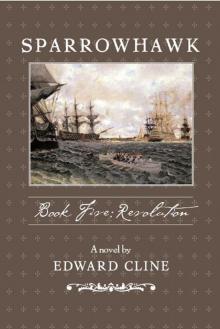 Revolution
Revolution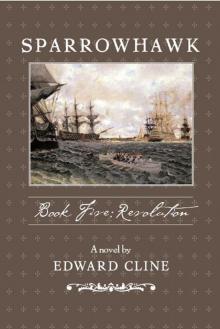 SH05_Revolution
SH05_Revolution War
War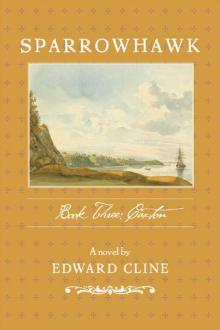 SH03_Sparrowhawk: Caxton
SH03_Sparrowhawk: Caxton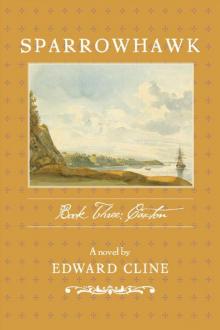 Sparrowhawk III
Sparrowhawk III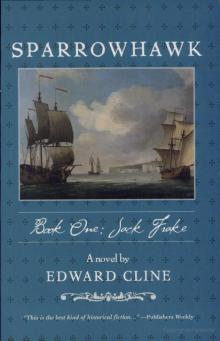 Jack Frake
Jack Frake SH04_Empire
SH04_Empire Empire
Empire SH01_Jack Frake
SH01_Jack Frake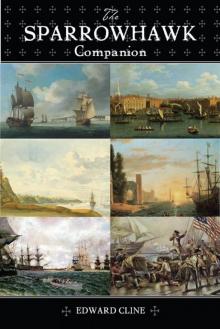 The Sparrowhawk Companion
The Sparrowhawk Companion Hugh Kenrick
Hugh Kenrick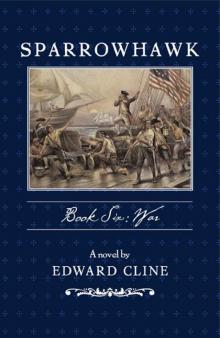 SH06_War
SH06_War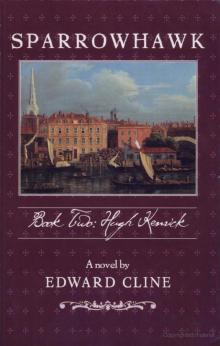 SH02_Hugh Kenrick
SH02_Hugh Kenrick